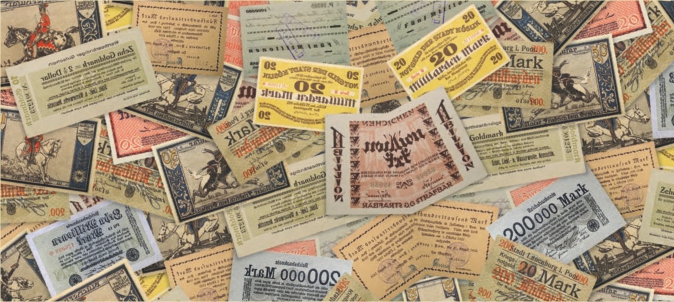Caution: The exhibition opening date is postponed one week, for Thursday, November 16th 2023 at 6:00 P.M. We apologize for the inconvenience.
The First World War led to a huge economic crisis in Pomerania and throughout Germany. More and more banknotes of larger and larger nominals were printed to meet rising state and social expenditure. The result was rising prices, especially for imported goods and raw materials.
In the summer of 1922, the country fell into a spiral of inflation, which turned into hyperinflation in the late autumn of 1923. At its peak, money was losing value almost hour by hour.
The specific nominals of official money missing from circulation were replaced by substitute money: coins and vouchers. They were most often issued by local authorities, financial institutions, industrial plants and sometimes even by private business people. Most of the substitute coins were issued between 1917 and 1918. Paper substitute money, called notgelds, was issued even earlier and the oldest ones had pfennig values. These were 'small' replacement money (Kleigeldscheine). As inflation progressed between 1918 and 1921, 'big' replacement money (Großnotgeld) appeared with denominations ranging from 5 to 100 marks. During the hyperinflationary period of 1922-1923, vouchers bore some of the characteristics of state banknotes: multicoloured double-sided printing, complex graphics and stylistically varied lettering.
Gradually, due to rising production costs and hasty printing, their layout began to be simplified. In late autumn 1923, at the height of hyperinflation, vouchers worth hundreds of billions and 1 trillion marks were introduced.
Quite soon after the introduction of substitute money, it became apparent that both coins and vouchers were willingly collected. A second trend of voucher production emerged, that functioned solely for collectors' needs and was detached from actual circulation. Whole series of vouchers were printed, like modern comic strips, telling a variety of often very amusing stories or legends. Longer subjects were divided into parts, each one placed on a different voucher.
Collectable notgelds also played a propaganda role, carrying political and social messages in addition to symbolic content.
In October 1923, the healing process of German currency, including substitute money, began. Legalising the widespread practice of paying with foreign currency, paper monetary instruments were allowed to be issued, the nominals of which were expressed in gold pfennigs (Goldpfennig) or gold marks (Goldmark). Their circulation was secured by gold or foreign currencies. Few issuers of money of this type appeared in Pomerania. Due to the considerable impoverishment of the region, it was difficult to obtain security for the issue, and the local economy was also influenced by the reliance on agriculture.
In November 1923, Rentenmark was introduced, based on a mortgage of national wealth, exchanged for 1 trillion paper marks. This restored public confidence in the state currency and created the conditions for its stabilisation. The final stage of the reform was the issuing of the Reichsmark and the exchange of the Rentenmark for the new currency at a ratio of 1:1. The exchange operation and the removal of the rest of the inflationary paper marks from the market were finally completed in 1925.
Money in Pomerania after World War I
17 November 2023–31 March 2024
vernissage: 16 November 2023, 6.00 P.M.
The National Museum in Szczecin – the Szczecin History Museum
ul. Księcia Mściwoja II 8
Curators: Genowefa Horoszko, Mieszko Pawłowski
Organizer: the National Museum in Szczecin
The project carried out in cooperation with Narodowy Bank Polski within economical education programme
